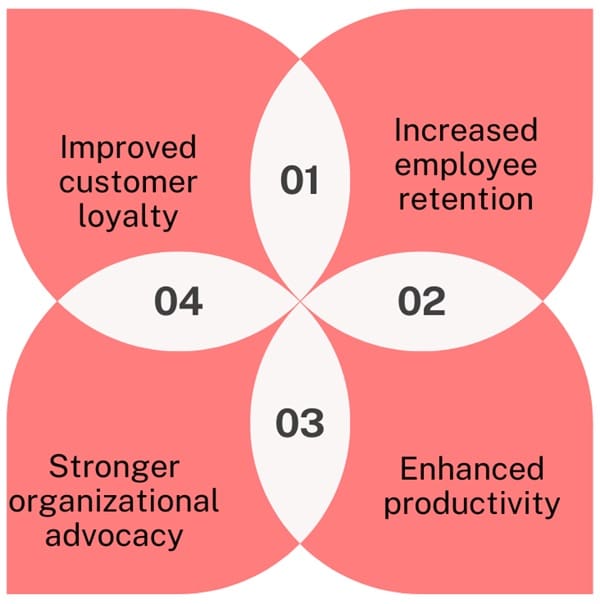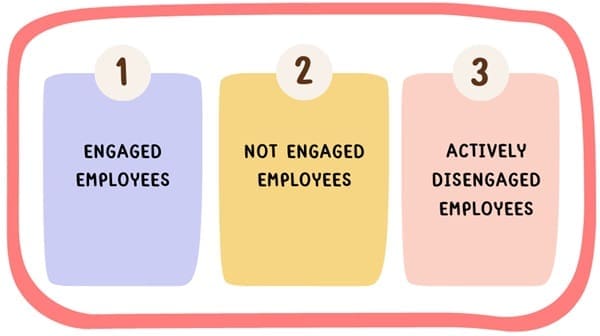Employee engagement is crucial for organizations as it brings significant benefits, such as higher productivity and lower employee turnover. Engaged employees are more committed, perform better, and are willing to put in extra effort to help the company succeed. As a result, many organizations, regardless of their size, have invested in policies and practices to foster this engagement.
Engaged employees go beyond simply meeting job expectations. They are passionate about their work, contribute to the organization’s goals, and are willing to take on challenges to improve themselves and the business.
To achieve this level of engagement, companies need to focus on factors such as effective communication, positive reinforcement, adequate resources, trust in leadership, and opportunities for skill development.
Simply having satisfied employees may not be enough, as they might only meet the minimum work requirements. True engagement requires motivating employees to fully apply their potential, be creative, and embrace challenges.
When employees feel valued, believe their work contributes to the organization’s goals, and see opportunities for personal growth, they are more likely to remain engaged and dedicated to the company’s success.
Table of contents
- What is Employee Engagement?
- Definition of Employee Engagement
- Creating an Engaging Culture
- Impact of Employee Engagement on Organizations
- Types of Employees Based on Engagement
- Common Misconceptions About Employee Engagement
- Steps to Foster Employee Engagement
- Enhancing Employee Engagement
- Final Words
- Related Articles
What is Employee Engagement?
Employee engagement refers to the emotional connection and commitment that employees feel towards their organization. This dedication drives them to put in extra effort to help the organization succeed.
Engaged employees exhibit care, enthusiasm, and accountability, which translates into going above and beyond their regular duties. They don’t just work to fulfil their tasks; they actively contribute to the organization by solving problems, picking up after others, and staying late when needed because they genuinely care about their workplace.
When employees feel emotionally invested in their company, they take pride in their work and are motivated to improve the organization. For instance, they might take the initiative in maintaining the cleanliness of the office or offer ideas for innovation, showing that their engagement goes beyond job satisfaction.
Definition of Employee Engagement
Employee engagement can be understood in multiple ways. Some view it as a psychological state where employees are fully absorbed and energized by their work, while others see it as a performance construct, emphasizing behaviours like discretionary effort and organizational citizenship.
What remains consistent across these interpretations is the idea that engagement reflects employees’ emotional investment in both their role and the organization.
Key definitions fall into three categories:
- Psychological/Emotional: Engagement is a mental state where employees feel committed, involved, and attached to their work.
- Performance-Based: Engaged employees show enhanced performance, productivity, and effort, often surpassing expectations.
- Organizational Relationship: Engagement is a two-way relationship where employees contribute to the organization, and the organization fosters a culture that encourages their involvement.
Types of Employee Engagement
- Work Engagement: This refers to a state of enthusiasm, energy (also called vigour), dedication, and deep involvement (absorption) in one’s work. Employees who exhibit these qualities are energized by their tasks and maintain a focused, positive mindset.
- Organizational Engagement: This form of engagement revolves around an employee’s connection to the organization itself. It reflects a strong sense of attachment to the company’s goals, values, and overall mission, fostering a sense of loyalty and a desire to contribute to its success.
Drivers of Employee Engagement

Several factors can influence employee engagement:
- Leadership and Vision: Clear and transparent leadership helps employees see how their roles align with the company’s larger goals.
- Managerial Support: Managers who show appreciation, treat employees as individuals, and create efficient work environments play a crucial role in boosting engagement.
- Employee Voice: Employees who feel heard and involved in decision-making are more likely to feel engaged.
- Organizational Integrity: A company that upholds its values and fosters trust among its employees promotes higher levels of engagement.
Benefits of Employee Engagement

Research consistently shows a strong link between employee engagement and improved business outcomes. Engaged employees contribute to higher productivity, lower turnover, and better financial performance. Companies with higher engagement levels report:
- Improved customer loyalty: Engaged employees are more attuned to customer needs, leading to better service and customer satisfaction.
- Increased employee retention: Engaged employees are more likely to remain with their organization, reducing the costs of hiring and training new staff.
- Enhanced productivity: Engaged employees are often more motivated, perform better, and are willing to put in extra effort to achieve organizational goals.
- Stronger organizational advocacy: Engaged employees are more likely to promote their company as a great place to work and recommend its products or services to others.
Studies show that organizations with high engagement levels can see significant financial benefits. For example, Towers Perrin found that companies with the highest levels of engagement saw a 19% increase in operating income and a 28% rise in earnings per share year over year.
Creating an Engaging Culture
Building a culture of engagement is essential for organizations to thrive. This involves creating an environment where employees feel valued, understood, and motivated to perform at their best. Engaged employees are more likely to “go the extra mile,” which can translate into higher profitability, better customer experiences, and long-term success.
Moreover, fostering engagement leads to a positive feedback loop. Engaged employees not only perform better but also boost their managers’ confidence and effectiveness. This increased managerial efficacy further enhances employee engagement, creating a cycle of mutual benefit that drives overall organizational performance.
Impact of Employee Engagement on Organizations
How employees are treated has a direct effect on their engagement levels. In fact, Gallup research in the UK (2011-2012) showed that only 17% of employees were engaged, while 57% were not engaged, and 26% were actively disengaged.
This demonstrates that disengaged employees significantly outnumber engaged ones, which can be detrimental to productivity. Research indicates that eliminating disengagement could lead to a massive boost in productivity—up to £70 billion annually across the UK.
Types of Employees Based on Engagement

- Engaged Employees: These individuals are passionate about their work and emotionally connected to their organization. They drive progress, innovate, and are productive because they are loyal and committed.
- Not Engaged Employees: While they do their jobs, they lack passion and a deeper connection to the organization. They are more likely to seek job opportunities elsewhere and perform the bare minimum.
- Actively Disengaged Employees: These employees aren’t just indifferent; they are unhappy and may openly express dissatisfaction. Their negative behaviour can harm team dynamics and business outcomes.
Also See: Lean Six Sigma Certification Programs, Aurora, Colorado
Common Misconceptions About Employee Engagement
Employee engagement is often misunderstood as either employee satisfaction or an HR-driven initiative. In reality, while activities like team-building or company events can boost morale, they don’t guarantee long-term engagement. Similarly, surveys may highlight problems but rarely offer actionable solutions.
True engagement requires a shift in how leadership interacts with employees, focusing on communication and trust, rather than viewing it as a one-off project led by the HR department.
Steps to Foster Employee Engagement

To successfully engage employees, organizations must:
- Evaluate: Understand what is working and what isn’t by gathering feedback and analyzing current engagement levels.
- Engage Leaders: Leaders need to be fully on board and committed. Coaching and developing leadership skills are essential for fostering employee engagement.
- Take Immediate Action: After identifying areas for improvement, it’s crucial to act quickly and show employees that their feedback is valued.
- Engage Teams: Involve employees in the changes being made. Let them know how leadership will support them, and set expectations for their role in driving engagement.
- Implement Long-term Changes: Embed new behaviours into the company culture through continuous coaching and management practices.
- Review Progress: Regularly assess the effectiveness of engagement initiatives, celebrating successes and making adjustments as needed.
Enhancing Employee Engagement
To enhance engagement, companies need to focus on both job-related and organizational factors. Actions such as designing challenging roles, offering rewards and recognition, fostering fair treatment, and ensuring that HR policies support development can help boost engagement. Moreover, creating a supportive environment where employees feel valued is crucial for maintaining engagement levels.
Ultimately, engagement is a two-way street—employers must provide a positive work culture, while employees decide the level of commitment they will offer in return.
Final Words
Employee engagement is not a one-time effort or a quick-fix initiative. It requires a cultural shift in leadership practices and consistent effort to create an environment where employees feel emotionally invested in their work. It’s this emotional connection that ultimately drives business success, making employee engagement a crucial aspect of organizational growth.
Over recent years, the relationship between employees and employers has changed. Globalization, increased competition, economic uncertainty, and the constant need for innovation have created new challenges for businesses.
Today, there is often no guarantee of job security, and expectations between employees and employers have evolved. In this environment, employee engagement becomes a key factor for organizational success.

About Six Sigma Development Solutions, Inc.
Six Sigma Development Solutions, Inc. offers onsite, public, and virtual Lean Six Sigma certification training. We are an Accredited Training Organization by the IASSC (International Association of Six Sigma Certification). We offer Lean Six Sigma Green Belt, Black Belt, and Yellow Belt, as well as LEAN certifications.
Book a Call and Let us know how we can help meet your training needs.



















